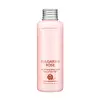What's inside
What's inside
 Key Ingredients
Key Ingredients

 Benefits
Benefits

 Concerns
Concerns

 Ingredients Side-by-side
Ingredients Side-by-side

Dipropylene Glycol
HumectantEthylhexyl Palmitate
EmollientButylene Glycol
HumectantHydrogenated Polydecene
EmollientCetyl Ethylhexanoate
EmollientCyclopentasiloxane
EmollientGlyceryl Stearate
EmollientPEG-100 Stearate
Butyrospermum Parkii Butter
Skin ConditioningDimethiconol
EmollientWater
Skin ConditioningRosa Damascena Flower Water
MaskingPhenoxyethanol
PreservativeHelianthus Annuus Seed Oil
EmollientRosa Hybrid Flower Extract
Skin ConditioningLilium Tigrinum Extract
Skin ConditioningIpomoea Purpurea Extract
Skin ConditioningCentaurea Cyanus Flower Extract
AstringentBorago Officinalis Extract
EmollientViola Mandshurica Flower Extract
AntioxidantSyringa Vulgaris Extract
Skin ConditioningCamellia Japonica Flower Extract
EmollientChrysanthemum Sinense Flower Extract
CleansingHelianthus Annuus Flower Extract
Skin ConditioningNarcissus Pseudo-Narcissus Flower Extract
Skin ConditioningPrunus Serrulata Flower Extract
Skin ConditioningPrunus Armeniaca Fruit Extract
Skin ConditioningNelumbo Nucifera Flower Extract
Skin Conditioning1,2-Hexanediol
Skin ConditioningGlycerin
HumectantAloe Barbadensis Leaf Extract
EmollientSodium Lactate
BufferingSodium Gluconate
Skin ConditioningPolysorbate 60
EmulsifyingSodium Hyaluronate
HumectantCetearyl Alcohol
EmollientSorbitan Sesquioleate
EmulsifyingStearic Acid
CleansingAcrylates/C10-30 Alkyl Acrylate Crosspolymer
Emulsion StabilisingParfum
MaskingPotassium Hydroxide
BufferingXanthan Gum
EmulsifyingDisodium EDTA
BHT
AntioxidantDipropylene Glycol, Ethylhexyl Palmitate, Butylene Glycol, Hydrogenated Polydecene, Cetyl Ethylhexanoate, Cyclopentasiloxane, Glyceryl Stearate, PEG-100 Stearate, Butyrospermum Parkii Butter, Dimethiconol, Water, Rosa Damascena Flower Water, Phenoxyethanol, Helianthus Annuus Seed Oil, Rosa Hybrid Flower Extract, Lilium Tigrinum Extract, Ipomoea Purpurea Extract, Centaurea Cyanus Flower Extract, Borago Officinalis Extract, Viola Mandshurica Flower Extract, Syringa Vulgaris Extract, Camellia Japonica Flower Extract, Chrysanthemum Sinense Flower Extract, Helianthus Annuus Flower Extract, Narcissus Pseudo-Narcissus Flower Extract, Prunus Serrulata Flower Extract, Prunus Armeniaca Fruit Extract, Nelumbo Nucifera Flower Extract, 1,2-Hexanediol, Glycerin, Aloe Barbadensis Leaf Extract, Sodium Lactate, Sodium Gluconate, Polysorbate 60, Sodium Hyaluronate, Cetearyl Alcohol, Sorbitan Sesquioleate, Stearic Acid, Acrylates/C10-30 Alkyl Acrylate Crosspolymer, Parfum, Potassium Hydroxide, Xanthan Gum, Disodium EDTA, BHT
Glycine Soja Oil
EmollientCorylus Avellana Seed Oil
EmollientSorbeth-30 Tetraoleate
EmulsifyingVitis Vinifera Seed Oil
EmollientOlea Europaea Fruit Oil
MaskingCaprylic/Capric Triglyceride
MaskingSqualane
EmollientIsoamyl Laurate
EmollientCamellia Japonica Seed Oil
EmollientOenothera Biennis Oil
EmollientSimmondsia Chinensis Seed Oil
EmollientHelianthus Annuus Seed Oil
EmollientArgania Spinosa Kernel Oil
EmollientOrbignya Oleifera Seed Oil
EmollientSaponaria Officinalis Leaf Extract
AntimicrobialCamellia Sinensis Leaf Extract
AntimicrobialOryza Sativa Bran Oil
EmollientRice Ferment Filtrate
Skin ConditioningDecyl Glucoside
CleansingGinkgo Biloba Leaf Extract
Skin ConditioningLavandula Angustifolia Oil
MaskingAloe Barbadensis Leaf Extract
EmollientCitrus Aurantium Dulcis Oil
MaskingMelaleuca Alternifolia Leaf Oil
AntioxidantTocopherol
AntioxidantGlycine Soja Oil, Corylus Avellana Seed Oil, Sorbeth-30 Tetraoleate, Vitis Vinifera Seed Oil, Olea Europaea Fruit Oil, Caprylic/Capric Triglyceride, Squalane, Isoamyl Laurate, Camellia Japonica Seed Oil, Oenothera Biennis Oil, Simmondsia Chinensis Seed Oil, Helianthus Annuus Seed Oil, Argania Spinosa Kernel Oil, Orbignya Oleifera Seed Oil, Saponaria Officinalis Leaf Extract, Camellia Sinensis Leaf Extract, Oryza Sativa Bran Oil, Rice Ferment Filtrate, Decyl Glucoside, Ginkgo Biloba Leaf Extract, Lavandula Angustifolia Oil, Aloe Barbadensis Leaf Extract, Citrus Aurantium Dulcis Oil, Melaleuca Alternifolia Leaf Oil, Tocopherol
 Reviews
Reviews

Ingredients Explained
These ingredients are found in both products.
Ingredients higher up in an ingredient list are typically present in a larger amount.
Aloe Barbadensis Leaf Extract is an extract of the leaves of the aloe, Aloe barbadensis, Liliaceae.
Aloe is one of the most well-known natural soothing ingredients, and for good reason. It’s full of water and has a cooling, calming effect on the skin, especially when it’s sunburned, itchy, or irritated. Aloe also helps your skin stay hydrated and smooth by mimicking what healthy skin naturally produces. On top of that, it contains vitamins and nutrients that support skin recovery.
It doesn’t protect you from the sun, but it can help your skin bounce back after too much time in it.
Let’s get into the details:
Aloe contains antioxidant Vitamins A, C, and E, which help fight off free radicals (unstable molecules from things like pollution that can damage your skin).
It’s also rich in polysaccharides, which are natural sugars that help hydrate the skin by acting like the skin’s own moisturizing agents. These, along with other sugars like monosaccharides, help form a protective barrier that locks in moisture.
Aloe works as both a humectant and an emollient. That means it draws water into the skin (humectant) and helps trap it there (emollient), making it an effective natural moisturizer.
You’ll also find a mix of other skin-supporting ingredients in aloe, including folic acid, choline, calcium, amino acids, fatty acids, and even Vitamin B12.
Out of the 420+ species of aloe, Aloe barbadensis is the most widely used in skincare products thanks to its gentle yet effective properties.
There are over 420 species of aloe but Aloe Barbadensis is the most commonly used for topical products.
Learn more about Aloe Barbadensis Leaf ExtractHelianthus Annuus Seed Oil is the oil derived from the seeds of a Sunflower. Sunflower seed oil is non-fragrant. It is an emollient, meaning it helps to soften the skin.
Sunflower seed oil contains many fatty acids. The fatty acids found in sunflower seeds include (from highest amount to least): linoleic acid, myristic acid, palmitic acid, stearic acid, arachidic acid, oleic acid, and linolenic acid.
These fatty acids help the skin create ceramides. Ceramides play a role in repairing the skin barrier.
Helianthus Annuus Seed Oil helps moisturize the skin. This in turn helps the skin look more rejuvenated and smoother.
Sunflowers are rich in vitamin E.
Historians believe Indigenous cultures of North America domesticated sunflowers before corn. Thus they relied on sunflower oil for a variety of uses. One such use is moisturizing skin and hair.
Sunflower seed oil may not be fungal acne safe. We recommend speaking with a professional if you have any concerns.
Learn more about Helianthus Annuus Seed Oil